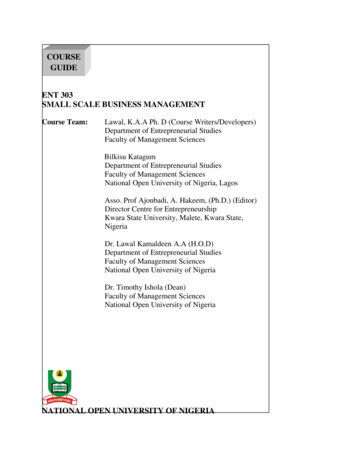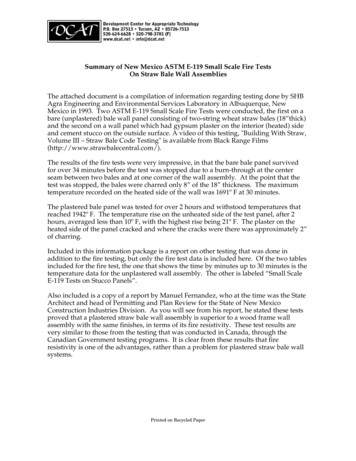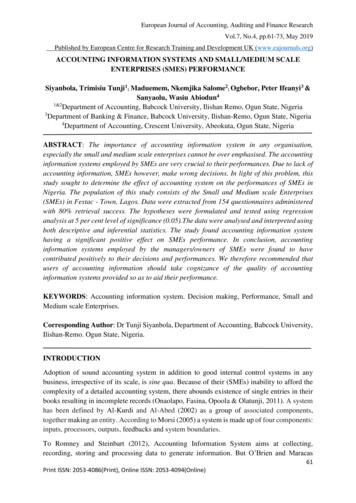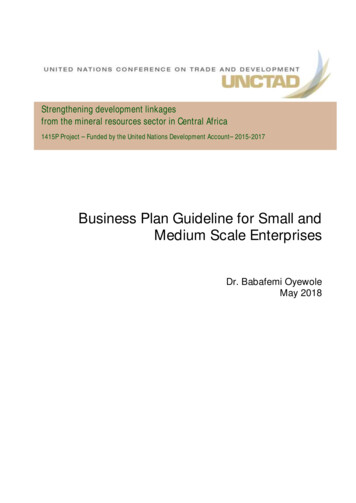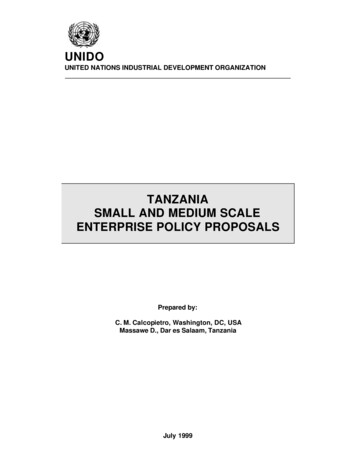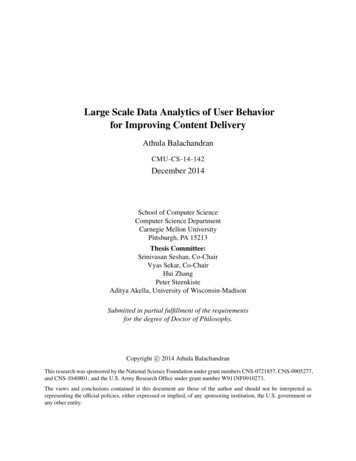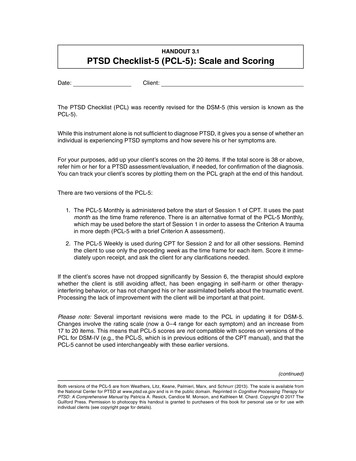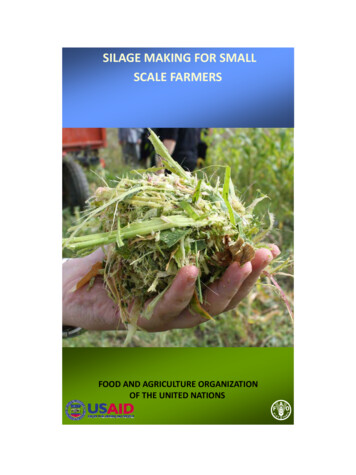
Transcription
SILAGE MAKING FOR SMALLSCALE FARMERSFOOD AND AGRICULTURE ORGANIZATIONOF THE UNITED NATIONS
IntroductionHow to improve the nutrition of farmers’ milking animals when each family keeps only one dairy cow?During the cold, continental winter, the major fodders available are wheat or maize straw, together withhay and concentrated feeds.As a minimum, it is essential to provide a green fodder supplement to enhance rumen function forbovine animals. Therefore, one should develop winter fodder crops.For smallholder farmers with limited production capacity, finding enough feed in the winter months tomaintain good milk production is always a problem. Many are forced to buy hay, concentrates or silagejust to keep their animals alive and are unable to benefit due to the higher prices paid for animal feedin the winter months.What is silage?Forage which has been grown while still green and nutritious can be conserved through a natural‘pickling’ process. Lactic acid is produced when the sugars in the forage plants are fermented by bacteria in a sealed container (‘silo’) with no air. Forage conserved this way is known as ‘ensiled forage’ or‘silage’ and will keep for up to three years without deteriorating. Silage is very palatable to livestockand can be fed at any time.Why silage not hay?Forages can be made into hay to conserve thenutrients, especially protein, before they decline inthe plant. However it is often too wet to dry thesuccessfully and special machinery, has to beused to assist the forage to dry quickly. Foragecrops such as maize, are too thick-stemmed todry successfully as hay.Silage is considered the better way to conserveforage crops. A forage crop can be cut early andonly has to have 30% dry matter to be ensiledsuccessfully. There is no need to dry out the plantmaterial any more than that, so wet weather is notsuch a constraint as it is with making hay.Silage making is long practiced by the larger agricultural sector, but the production method relieson heavy equipment and large production, inorder to dig or build storage pits and to compressthe green mass, putting it beyond the reach ofsmallholder farmers.Disadvantages: Silage is not interesting for marketing as itsvalue is difficult to be determined.It does not allow longer transportation;The weight increases manipulation costs;Has considerably lower vitamin D content compared to hay.Advantages: Stabile composition of the feed (silage) for alonger period (up to 5 years); Plants can be harvested at optimal phase ofdevelopment and are efficiently used by livestock. Reduction of nutrient loses which in standardhay production may amount to 30% of the drymatter (in silage is usually below 10%); More economical use of plants with high yield ofgreen mass;Better use of the land with 2-3 crops annually;Silage is produced in both cold and cloudyweather; The fermentation in silage reduces harmfulnitrates accumulated in plants duringdroughts and in over-fertilized crops.Allows by-products (from sugar beat processing, maize straw, etc.) to be optimallyused;Requires 10 times less storage spacecompared to hay;Maize silage has 30-50% higher nutritivevalue compared to maize grain and maizestraw;2 kg of silage (70% moisture) has theequal nutritive value of 1 kg of hay.2
Principle of silage makingAt harvest, plant cells do not immediately “die”; they continue to respire as long as they remain adequately hydrated and oxygen is available. The oxygen is necessary for the physiological process of respiration, which provides energy for functioning cells. In this process, carbohydrates (plant sugars) are consumed(oxidized) by plant cells in the presence of oxygen to yield carbon dioxide, water and heat: sugar oxygen carbon dioxide water heatOnce in the silo, certain yeasts, molds and bacteria that occur naturally on forage plants can also reachpopulations large enough to be significant sources of respiration. In the silage mass, the heat generatedduring respiration is not readily dissipated, and therefore the temperature of the silage rises.Although a slight rise in temperature from 80 to 90 F is acceptable, the goal is to limit respiration byeliminating air (oxygen) trapped in the forage mass.Some air will be incorporated into any silo during the filling process, and a slight increase in silage temperature is l kely. These temperature increases can clearly be limited by harvesting at the proper moisture content and by increasing the bu k density of the silage. Generally, it is desirable to limit respirationduring the fermentation process by using common sense techniques that include close inspection of thesilo walls prior to filling, harvesting the forage at the proper moisture content, adjusting the chopper properly (fineness of chop), rapid filling, thorough packing, prompt sealing and close inspection of plastics forholes.
Dry matter and moistureIdeally, corn silage should be harvested at the moisture content appropriate for the type of silo used.Recommended moisture contents are 65–70 percent for horizontal silos, 63–68 percent for conventional tower silos, 55–60 percent for limited-oxygen silos, and 65 percent for silo bags.Corn silage yield and quality as influenced by growth stage.Maturity StageMoisture %Early dent731/2milkline663/4milkline63no milkline60Delaying harvest can reduce both the fiber and starch digest bility as the stover gets more lignified andthe overmature kernels become harder and less digestible if left unbroken after ensiling. Corn that isensiled extremely wet will ferment poorly and lose nutrients by seepage, which also has potential todamage the silo and if not contained, contaminate local water supplies. Another problem with chopping silage with too much moisture is that a larger amount of lactic acid is needed to reduce the pH.This results in a longer period of time before the silage becomes fermented, producing a lower qualitysilage. Silage that is too dry may result in poorly packed material, causing more mold and spoilagedue to air trapped in the silage. In dry, over mature corn silage, the stover portion of the plant is lessdigestible and contains lower amounts of sugars and vitamin A. It will not pack well in the silo, moreoxygen will be present and it will take longer to get through the aerobic phase into the anaerobicphase of fermentation. Nutrients will be used for respiration during the aerobic phase, the temperatureof the silage will increase and possibly burn.Parts of plantGrainDry matter in early wax ripeningphase (%)Dry matter in early wax ripening phase (%)3342892219292486CobsLeafStemCob sheetsThe approximate moisture level of chopped silage can be determined by means of a “grab test.”Squeeze the chopped forage tightly into a ball for 20 to 30 seconds, and then release quickly. Forage chopped into 3/8 to 1/2-inch pieces should be used.Dry matter is the most important factor for production of good quality silage. The optimal qualitysilage is produced from components with dry matter contents ranging between 30 and 35%.In the following table the percentage of moisture in different parts of the maize plant are shown, aswell as the ideal time for harvest for silage preparation.Condition of the forage ballApproximate moisture contentball holds its shape and there is considerable freejuiceOver 75%ball holds its shape but there is very little freejuice70 to 75%ball falls apart slowly and there is no free juice60 t0 70 %ball falls apart rapidlyBelow 60 %
Increased moisture or lack of dry matter in silage components should be avoided when possible, as theactivity of the lacto-acidic bacteria is decreased and the activity of the butyric acid producing bacteria isincreased. The optimal quantity of dry matter is achieved in the last phase of vegetation of the plants.When the weather conditions do not allow timely harvest, resulting in too wet or too dry silage materials,the desired moisture can be achieved by mixing dry and wet components. The composition of the dry andwet components is determined through use of the Pierces’ square as show below:Whole alfalfa, 45%15 parts, or 60 %30%Whole maize plants,45% dry matter10 parts, or 40 %25 parts, or 100 %Example: If you are producing silage from whole maize plants and freshly harvested alfalfa. In the middle of the square you indicate the desired dry matter contents of the silage (for example 30%). On theleft side of the square in the upper corner, you indicate the dry matter of the fresh alfalfa and in thelower square, the dry matter of the whole maize plant (45%). By deducting the smaller numbers fromthe bigger ones, you get the needed percentage of each component that has to be combined in order toachieve the desired dry matter contents. In this case the fresh alfalfa should be included with 15 parts,or 60% and that of the whole maize plant, 10 parts, or 40% of total quantity, resulting in average drymatter of 30%.
Preparation of silage from whole maize plantsCorn harvested for silage is an important feed crop, where cropland often is limited. The crop provideslivestock producers with a high-yielding, relatively consistent source of forage and the animals with ahighly digestible and palatable feed. Corn silage produces more energy per acre than any other cropCorn silage serves as a high-energy forage for dairy cows. This is most important for high-producingherds and on farms experiencing problems with making or buying high quality hay crop forage. Cornsilage, with its relatively high-energy content, is also well adapted for use in low-cost rations for fattening cattle. Corn silage requires less labor per ton to produce than many other forage crops. It can extend the harvest period for the entire corn acreage and provide an opportunity for salvage of stressedor damaged cornfields. Also, corn silage can efficiently recycle plant nutrients, especially largeamounts of N and K. The most adequate moment for harvest of maize during the vegetation is the socalled wax ripening phase of the maize grain.The presence of a dark colored layer at the base of the maize grain is also an indicator for the appropriate time of harvest for silage production. Once the first grains with dark layer are noticed you shouldwait for 3-4 weeks more before harvesting.At this time the average dry matter contents of the maize plant is 30-35%. After the indicated phase,the contents of dry matter decreases as the stems get broken and leafs fall off. The maize can besilaged with or without other components. The whole maize plant should be harvested by cutting it 1012 cm from the ground.The particles of the maize plant, when chopping it for silage should be between one and three centimeters in length, although the optimal length depends on the vegetation phase as shown in the table.Phase of vegetableDry matter(%)Length of particle (cm)Milk20-253-5Milk - Wax25-301-3Wax30-350.7-1
Combined silageIf more crops are available, it is highly recommendable to produce silage trough combining of moreproducts or by products. The most economically feasible results are obtained when low quality components, (crops that cannot be silaged on their own, such as fruits and leafs of sugar beat and sunflower)are added to more qualitative components (maize, alfalfa etc.) up to 30%.As an example, high quality silage can be produced from whole plant of maize (45%), maize cone andgrain (25%) and fresh alfalfa (30%).Leafs and fruits of sugar beat can be also used for preparation of combined silage, as they containsufficient sugar percentage (4-6%). The best combination is sugar beat leafs and fruit, together withwhole maize plants or maize straw. A main success condition is that the sugar beat does not havemuch earth in it.When you combine sugar beat with whole maize plants for silage production, it is best to use maizeplants in a later stage of vegetation.The sugar beat contents depends on the dry matter of the maize plant and usually in the total mixturecontributes with 25-30%.Silage production from drought affected cropsWhen corn is so drought stressed that it may not resume growth, it should be ensiled. Corn in thiscondition usually has few ears and has leaves that have turned brown and are falling off. The net energy content of drought damaged corn often is 85–100 percent of normal, and it sometimes containsslightly more crude protein. Drought stunted silage often contains high fiber digestibility, so when it issupplemented with additional grain, it can be an excellent forage and sustain high milk production.One concern with drought-stressed corn is the potential for high nitrate levels in the silage. High nitratelevels are found where nitrogen rates were applied and when a drought-stressed crop was choppedwithin three days following a rain. Ensiling crops that are suspected to have high nitrate levels is preferred to green chopping, because fermentation will decrease nitrate levels by about 50 percent. Hightemperature and drought causes accumulation of nitrogen in plants, which affects significantly theconversion of the feed. The lactic acid produced when silaging reduces the nitrogen content in plants.Silage production from frosted cornCorn is occasionally damaged or killed by frost before it reaches the desired maturity for ensiling. If thefrost is early and green leaves remain on the plant, the crop will continue to accumulate dry matter andshould be left in the field until it reaches the appropriate moisture content. Plants that are killed andstill immature will likely contain too much moisture for immediate ensiling. These plants will dry slowlyand dry matter losses will increase as the dead plants drop their leaves in the field and sugars leachfrom the frosted leaves. The best option is to leave the crop in the field to dry to an acceptable level (atleast 72 percent moisture for a horizontal silo), unless it appears dry matter losses are becoming toohigh or harvesting losses will increase dramatically.
Silage in bagsThe 'new' method, whereby cut green mass is stored in large sacks made from polythene, has in factbeen tested in research stations for some years. It is not, however, a complex process. Ideally, thegreen mass is cut into small pieces, of about 3 cm long, and these, are used to fill the bags. The material is pressed removing the air and thereby preventing decomposition once the bag has been filled andshut. The feed can be stored in this way, without losing the nutritive quality, for up to a year. This allowsfarmers to maintain feed levels through the winter.The purpose of chopping and compacting forage for silage is: To release as much plant sugar as possible for fermentationTo ensure that all the air is pushed out of the plant material so that when the silo issealed, the plant material is free of air. This is when fermentation works best to produce lactic acid.Chopping can be done by hand but this can take too much time for forage on more than 0.1 hectares,so it is preferable that a forage chopper be used.It is important to time the cutting of the forage so that the cut forage is not sitting for more than a daywaiting to be chopped and ensiled, otherwise it will become moldy or to dry.It is important that once the forage has been chopped it is placed in the silos and compacted as muchas possible to get the air out before the silo is sealed. A key feature of silage bags is that it allows conservation of available fodder in small quantities, over a long period of time. This strongly contrasts withtraditional silage making techniques, where large amounts of fodder are harvested and chopped at onetime. As example a farmer family might conserve a couple of bags a day over the growing season,which would allow their milking animal to be fed over the 200 days of autumn and winter. The foddermight include all parts of the corn plant, leafy grass weeds, etc., which could be also partly air-driedbefore chopping and ensiling. It is also possible to progressively remove leaves from maize plants asthey commence to senesce.Advantages Plastics silage bags are an economical alternative to traditional silage storage systems, such as pitsand silos when related, harvest and storage losses are considered.It is an effective way for preserving feed with minimum nutrient loss. (The anaerobic environmentthat is created eliminates spoilage from the growth of yeasts, molds and adverse bacteria whilemaintaining essential proteins and nutrients).Allows farmers to store silage anywhere they need it. A well graded and well drained ground surfaceis all that is necessary.The silage is completely sealed in the bag. This means that all the acid is retained in the silage,unl ke that in pit silage when it seeps out through the bottom of the pit as effluent. This compensatesfor the longer pieces of forage and poorer compaction than that found with silage machinery, so thatthe quality of the silage is just as good.Ensiling in a bag avoids the hard work of having to remove silage, as it has to be from a pit, when ithas to be dug out every day.Because the whole bag is fed out to the animal, it means the rest of the silage which is in the otherbags is not exposed to air at removal and is therefore unspoiled. Much of the silage in pit s hasbeen found to be spoiled due to poor sealing and exposure to air every day when the silage is removed for feeding.The bag is easily stored and easily portable so that any member of the family can carry it to the feedtrough for the cow.8
DisadvantagesThere are a few disadvantages to using silage bags. Among them are: the importance of pest control to prevent damage on the bags,containment and disposal of the plastic, once silage is removed from the bag,the need to chop the green mass, as chopped material tends to make much better silage,because more air can be squeezed out of it during the packing process, and the small piecescannot puncture the bag.With careful planning, all of these obstacles can be overcome. Most loses of silage during the processoccur due to: Seepage losses when dry matter is less than 32 %. Unnoticed bird/rodent damage to the bags resulting in spoilage loss. Too wet (gaseous/seepage losses) or too dry silage (spoilage).StorageIt is important to pick a suitable location for the storage bags. Obviously, one would wish to keep themrelatively close, in an area that has adequate drainage and easy access. Keeping the bags away fromother feed sources, may reduce damage from birds and rodents. Stacking the carefully in a room canprotect them against rats, mice and other pests. Although open storing in a way disabling rodents toform layers, and covering with a thin plastic foil to prevent damage from birds is sometimes most effective. The surface area selected for storage of silage bags has a large impact on silage quality and easeof feeding from the bag. Based on experience the surfaces rated as follows: Concrete Pad. Provides excellent surface for silage bag, easy removal of feed with little or nodamage, can achieve exceptional drainage of water away from bags, discourages pests andmakes inspection for damaged bags very easy.Asphalt surface. Less expensive than concrete. Has most of the same advantages of concrete.Precautions to maintain surface adequate during the hottest hours on summer days.Gravel. Is good surface for placing silage bags. Weed and pest control are quite good. Howeverthe crushed rock surface does not support traffic very well.Dirt surface. This can work if there is adequate drainage away from bags. Weed control must bepracticed and it is very helpful to have a second location of silage for use when it is extremely wet,especially in spring.
PackingPacking the silage bag correctly is the most important factor that will affect silage quality. Therefore,the following recommendations should be followed when selecting the packing materials. Select a good bag. Strong high density plastic bags (from fertilizer bags to shopping bags) areavailable, with capacity from 50 - 5 kg of fresh chopped green fodder. Bags with no obvious holescan be purchased in packs of from ten to hundred;The quality of bags used is important. High- rather than low-density plastic reduces the potentialfor tearing. The seal must be without holes and this may relate to factory practice. If holes arepresent along the seal, sticky tape or tar/mastic may be used to repair seals as the bags are tied.Inner bags (if more bags are used) also tend to get damaged, but thicker bags are always lessdamaged, to the extent that two rather than three layers of bags are sufficient.Plastic fertilizer bags make very good silos. The fertilizer bag will last for at last three seasons.MaintenanceAs damage on the bags can happen for various reasons, birds, rodents, and other animals can puncturethe plastic. This lets air in the bag and can result in spoilage. Children and cattle can do the same. Formaintenance of the stored bags containing the silage the following recommendations should be followed: Inspect the bags on a regular basis and if possible mend holes;Do not allow dogs, cats and other animals to climb the bags;Number and date the bags for easy identification and recall of materials bagged;Do not leave the silage bags opened over night;Inspect frequently and seal holes at once;If damage is extensive, the silage needs to be re-bagged as soon as possible;If maintenance is appropriate after three – five weeks, excellent lactic acid fermentation will result andbags kept well for six months, with no or little fungal spoilage.After emptying, the bags must be carefully washed, dried and stored in a safe place for use the follow10ing year.
FillingWhile filling your silage bags: Do not allow the feed to become contaminated with dirt;Ensile at proper maturity and moisture (58% - 68%);If moisture levels are higher, reduce the packing pressure to avoid creating mushy, silage, or better yet, wait until the forage is drier; If moisturelevels slip below 65%, increasing the packing pressure can help;Pack not later than 24 hours after harvest.Fill rapidly and pack uniformly. Each bag should be filled in one or two hours at maximum. This isneeded to maintain forage consistency;The silage must be packed as densely as possible, in order to avoid air pockets that can interferewith proper fermentation. Air pockets can develop more frequently when longer chop lengths areused.Monitor particle length. A shorter chop length of 3/8-cm will pack better, but may not retainenough physical fiber for the ration.The fodder can be hand chopped, or chopped through a cutter;5 – 50 kg of chopped green fodder is carefully packed into a bag, in order to avoid making anyholes in the bag;the bag is gently but firmly squeezed by hand to expel air, and while compressed, the bag isclosed;Rodent controlSilage bags, especially silage from fodder maize attract rodents. Once in, rodents could easily hidebetween bags, chewing through the plastic bags, and resulting in aerobic spoilage. Monitor the silage bags on a regular basis for any rodent, bird or livestock damage;Do not use elemental sulfur or chemical means for rodent/pest control, as life expectancy of theplastic is reduced when exposed to chemicals;Frequently some form of construction may be required. This might be within an existing storesuch as large cement or clay storages jars;Alternatively, storage (shelves) can be constructed with legs in order to keep the store off theground, shaped in a way to prevent rats and mice climbing (such as mushroom shaped legsused for grain stores, or protected legs with metal horizontal discs or downward facing cones).
Sealing the bagIf bags are used, leaning heavily on the forage material in the bag then tying the remaining plastic asclose to the material as poss ble and as tightly as possible, will compact the silage and then seal itfrom air. Make sure there is enough plastic to tie, up, so that it does not come free from the twine.Tobacco twine or hay baling twine is best for tying up the bag and it should be twined around the topof the bag several times to ensure the bag is completely sealed. Remember to seal tightly. Severalmethods can be used to seal the bags: For larger bags. Stretch the remaining plastic as far as it will reach, then place a wooden boardon the plastic and wrap it around the board back toward the bag, like re-sealing a bag of potatochips;For smaller bags, the neck of the bag was twisted then turned over and tied with twine;You can also practice nailing of wooden boards to the one used to wrap the end of the plasticbag. Just roll the board and plastic two or three times and place a second board on the top. Nailthe two boards together slightly alternating the angle of the nails.Contents Fodder with high sugar content, will conservewell;Fodder with low sugar content is more likelyto rot than ferment;Many crop residues lose much of their soluble carbohydrates during the final stages ofgrain ripening, and while the residue is left todry in the field;The drier the silage, the more dry matter ispacked into a given volume but the moresusceptible is to air movement and dry matter losses;Densities also tend to decrease as particlesize increases.Evaluation corn silageOnce the silage has undergone an adequate fermentation, usually in 3 weeks. Evaluation of the silage pHand fermentation acids can provide feedback on whether the fermentation occurred under ideal conditionsusing a pH sensitive paper. In general, pH values for corn silage should be in the 3.5 to 4.3 range, lacticacid levels should be in the 4–6% range, acetic acid 2% or less, propionic acid 0–1%, and butyric acid lessthan 0.1%. Ammonia N levels should be less than 5%. Other factors that can be used to evaluate thesilage include temperature, smell, and the appearance of the silage. Silage temperatures should generallybe within 15 to 200F of the ambient temperature. Higher temperatures indicate that oxygen is penetratinginto the silage and resulting in aerobic decomposition. The silage should also not have a rancid odor, associated with clostridial fermentation in wet silages. A vinegar odor can also be associated with wet silages that have high levels of acetic acid. An alcohol odor is associated with fermentation by yeast, whichresults from slow feed out rates and air penetration in the silage face. There should also not be any visiblemold in the silage, which is often an indication of high dry-matter content at ensiling or poor sealing.Making a field assessment:Step 1: Collect a sample of silage that is representative of what is to be fed to the animals.Step 2: Make an assessment of the silage on physical appearance and texture.Step 3: Make an assessment of the silage on the basis of color.Step 4: Make an assessment of the silage on the basis of the aroma of the silage.12
Physical Appearance and TextureSilage Characteristics and InterpretationLeafy, soft textureLeafy, but leaves more fibrousLikely to have high ME. Crude protein is probably high. ME for leafy tropical pasture silages is lower than for temperate pasture silages at thesame growth stage.Stemmy, fibrous; seed heads presentLower digestibility and ME. More typical of tropical grasses.Proportion of legumeIf high proportion of stems/or seed heads are present, ME and crudeprotein are likely to be low. Crop cut too late.present in silagePresence of mould or rottensilageVery wet; effluent seepingfrom stack or ponding in bottom ofwrapped bales.Very dry, even brittleColorVery dark olive greenDark olive green/brownLight green to green/brownAs the proportion of legume increases, silage crude protein content (andoften ME content) will increase.Air has entered the silage. DM has been lost and silage quality (ME content) will have declined during storage.Moisture easily squeezed out of he silage. Forage was ensiled at too lowa DM content. There is a high risk of poor fermentation and significantlosses (quality and quantity).Silage was ensiled at too high a DM content. The forage was probablypoorly compacted and there is a high risk of overheating during storage,increased silage losses, reduced ME and protein degradation.Silage Characteristics and InterpretationWeather damaged, and/or very wet silage with a poor fermentation. Souror putrid aroma. Usually occurs if high legume content, or immature grassthat may have been fertilized with a high rate of nitrogen.Normal color for wilted legumes, which are usually a darker color hangrass silages.Normal color range for grass, cereal and maize silages.Normal color range for wilted grass silages. Heavily wilted silages wi hrestricted fermentation tend to be greener.Pale green/straw yellowLight amber brownBrownDark brownAromaMild, pleasantly acidic, sourmilk or natural yoghurt smellVery little smell, but slightsweet aromaSweet, fruity alcoholic aromaSour vinegar smellRancid butter, putrid aromaStrong tobacco or caramelsmell, with flavor of burntsugarMusty or moldy aromawith only mild fermentationaromaTypical of late-cut grass and cereal silages. Can occur with low DM silages, and weather-damaged grass silages. Bottom layer of wet silagecan be yellow with fruity aroma.Some heating has occurred during storage or due to aerobic spoilageduring feedout. Some loss in digestibility and heat damage of protein.More common wi h wilted silages.More extensive heating. May also be some black patches of silage on thesurface. Significant loss in digestibility and high proportion of protein isheat damaged and unavailable to the animal. Inadequate compaction,delayed sealing or poor air exclusion. Usually accompanied by significantproportion of waste (moldy) silage.Silage Characteristics and InterpretationNormal lactic acid fermentation – desirable.Heavily wilted silage with little fermentation, especially from crops withlow sugar content. Stronger aroma as DM content falls.Yeasts have played an active role in the fermentation. Ethanol levelshigh. These silages are of
Corn harvested for silage is an important feed crop, where cropland often is limited. The crop provid
